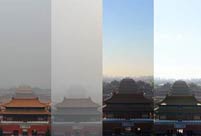Ji Taiping believes such residence's disappearance would be tragic. He points out Pingyao's future will be determined by what its ancient houses contain - its people.
Pingyao was settled in the Western Zhou Dynasty (c.11th century- 771 BC) and expanded to its present scale in the Ming Dynasty (1368-1644). It became the country's financial center during the Qing Dynasty (1644-1911), when it housed 20 financial institutions - more than half the nation's.
It was the headquarter of the country's first bank, Rishengchang, which controlled about half the national silver trade in its golden age.
Pingyao's architectural legacy was largely built upon this commercial prosperity.
The city remains among the world's best-preserved. The city wall is the crown of its imperial history, but its jewels are the more than 3,700 ancient houses studding the 2.25 square kilometers the bulwark sheaths.
However, the tourist throngs who come to marvel at the architectural treasure trove have inadvertently brought tarnish to the private homes as some locals renovate their houses into larger hostels to make money.
Others simply leave their houses to decay because ancient structures' renovations cost about twice as much as modern concrete buildings'.
That's where the new model came in last year. It's devised to encourage individual families to invest while the government and World Heritage Fund subsidize renovations' finance and technical management.
The deal is available to any private owner of a house with historical value, intact structure and clear ownership. Houses renovated through the project can't be used for commercial purposes.
"They were built for living in and will be renovated for the same purpose," Ji says. "Life in Pingyao will go on and the city will have a future only if people are willing to stay."
Liu Chuanjing has lived in his courtyard since 1943. The tiled roof leaked, the walls were cracked and the pine gate was rotting.


 Luxury-cars parade held in Dubai
Luxury-cars parade held in Dubai Special forces take tough training sessions
Special forces take tough training sessions Fire guts 22-storey Nigeria commercial building in Lagos
Fire guts 22-storey Nigeria commercial building in Lagos A girl takes care of paralyzed father for 10 years
A girl takes care of paralyzed father for 10 years A record of Beijing air quality change
A record of Beijing air quality change In pictures: explosions occur in Taiyuan
In pictures: explosions occur in Taiyuan Hello! Horror Halloween Celebration!
Hello! Horror Halloween Celebration!  The catwalk to the world of fashion
The catwalk to the world of fashion  Cruise trip to Taiwan
Cruise trip to Taiwan  Maritime counter-terrorism drill
Maritime counter-terrorism drill Loyal dog waits for master for six months
Loyal dog waits for master for six months Oriental education or western education?
Oriental education or western education? China in autumn: Kingdom of red and golden
China in autumn: Kingdom of red and golden National Geographic Traveler Photo Contest
National Geographic Traveler Photo Contest Chinese screen goddesses from Beijing Film Academy
Chinese screen goddesses from Beijing Film Academy Day|Week|Month